Dynamique de la monnaie et des prix sous le régime de l’étalon-or dans la théorie néoclassique de la croissance
DOI :
https://doi.org/10.17533/udea.le.n90a02Mots-clés :
étalon-or, modèle de croissance, accumulation de richesse, inflationRésumé
L’objectif de cette étude est de déterminer la dynamique de la quantité de monnaie et des prix sous un régime de l’étalon-or dans
un modèle de croissance néoclassique à un secteur. Pour cela, un modèle est construit à l’aide de quelques approximations de la littérature sur la théorie de la dynamique économique. En particulier, le secteur productif est basé sur le modèle de Solow, l’hypothèse de l’étalon-or et la dynamique des prix sont basés sur Barro (1979) et la demande de monnaie est influencée par le cadre traditionnel où la monnaie rentre dans la fonction d’utilité. Le modèle intègre les idées de ces différentes approches dans une seule structure compacte. Des simulations montrent que le système économique est caractérisé par un état stationnaire unique et instable. Des analyses dynamiques comparatives sont également effectuées à partir des modifications dans certains paramètres.
Téléchargements
Références
Azariadis, Costas (1993). Intertemporal Macroeconomics. Oxford: Blackwell.
Barro, Robert J. (1979). “Money and the Price Level under the Gold Standard”, Economic Journal, Vol. 89, No. 353, pp. 13-33.
Barro, Robert J. & Sala-i-Martin, Xavier (1995). Economic Growth. New York: McGraw-Hill Inc.
Bohanon, Cecil E.; Lynch, Gerald J. & van Cott, T. Norman (1985). “A Supply and Demand Exposition of the Operation of a Gold Standard in a Closed Economy”, Journal of Economic Education, Vol. 16, No. 1, pp. 16-26.
Bordo, Michael David & Ellson, Richard Wayne (1985). “A Model of the Classical Gold Standard with Depletion”, Journal of Monetary Economic, Vol. 16, No. 1, pp. 109-120.
Burmeister, Edward & Dobell, Rodney (1995). Mathematical Theories of Economic Growth. London: MacMillan.
Cagan, Phillip (1956). “The Monetary Dynamics of Hyperinflation”. In Friedman, M. (Ed.), Studies in the Quantity Theory of Money (pp. 25-117). Chicago: University of Chicago Press.
Chappell, David & Dowd, Kevin (1997). “A Simple Model of the Gold Standard”, Journal of Money, Credit and Banking, Vol. 29. No. 1, pp. 94-105.
Dempster N. (2009, July). “Gold as a Tactical Inflation Hedge and Long-term Strategic Asset”, World Gold Council. Retrieved from: http://www.gold.org/download/rs_archive/AssetAllocation_Inflation_July09.pdf.
Dowd, Kevis & Sampson, Anthony A. (1993). “A New Model of the Gold Standard”, The Canadian Journal of Economics, Vol. 26, No. 2, pp. 380-391.
Dubey, Pradeep; Geanakoplos, John & Shubik, Martin (2003). “Is Gold an Efficient Store of Value”, Economic Theory, Vol. 21, No. 4, pp. 767-782.
Goldman, Steven M. (1972). “Hyperinflation and the Rate of Growth in the Money Supply”, Journal of Economic Theory, Vol. 5, No. 2, pp. 250-257.
Keynes, John Maynard et al. (1943). “Proposals by British Experts for an International Clearing Union”, In Proceedings and Documents of the United Nations Monetary and Financial Conference vol. 2. Washington: U.S. Government Printing Office, 1948.
Lehrman, Lewis (1981, 30 July). The Case for a Gold Standard. Wall Street Journal.
Mundell, R. A. (1968). International Economics. New York: Macmillan.
Patinkin, Don (1965). Money, Interest, and Prices: An Integration of Monetary and Value Theory (2nd Ed.). New York: Harper & Row.
Ranson, David (2005). “Inflation Protection: Why Gold Works Better Than Other Linkers”, World Gold Council. Retrieved from: http://www.gold.org/download/rs_archive/inflation_linkers.pdf.
Ricardo, David (1911). The Principles of Political Economy and Taxation. London: J. M. Dent & Sons. (Original work published 1821).
Sargent, Thomas J. & Wallace, Neil (1973). “The Stability of Models of Money and Growth with Perfect Foresight”, Econometrica, Vol. 41, No. 6, pp. 1043-1048.
Seemuang, Ananya & Rompreert, Suppanunta (2013). “Gold Value Movement and Macroeconomics”, Journal of Business and Economics, Vol. 4, No. 8, pp. 752-60.
Sidrauski, Miguel (1967). “Rational Choice and Patterns of Growth in a Monetary Economy”, American Economic Review, Vol. 57, No. 2, pp. 534-544.
Solow, Robert (1956). “A Contribution to the Theory of Growth”, The Quarterly Journal of Economics, Vol. 70, No. 1, pp. 65-94.
Thomas, H. (2015, 5 june). Don’t Expect Peak Gold Prospects to Mean New Price Heights. Wall Street Journal.
Tobin, James (1965). “Money and Economic Growth”, Econometrica, Vol. 33, No. 4, pp. 671-684.
Triffin, Robert (1960). Gold and the Dollar Crisis. New Haven: Yale University Press.
Wanniski, Jude (1981, 7 December). Supply-Side Case for a Gold Standard. Business Week.
Zhang, Wei-Bin (1993). “Woman’s Labor Participation and Economic Growth - Creativity, Knowledge Utilization and Family Preference”, Economics Letters, Vol. 42, No. 1, pp. 105-110.
Zhang, Wei-Bin (2005). Economic Growth Theory. Hampshire: Ashgate.
Zhang, Wei-Bin (2006). Growth with Income and Wealth Distribution. London: Macmillan.
Zhang, Wei-Bin (2009). “A Small Open Interregional Monetary Economic Growth with the MIU Approach”, Annals of the Alexandru Ioan Cuza University of Iasi, Vol. 56, pp. 210-234.
Téléchargements
Publié-e
Comment citer
Numéro
Rubrique
Licence
(c) Tous droits réservés Wei-Bin Zhang 2018

Cette œuvre est sous licence Creative Commons Attribution - Pas d'Utilisation Commerciale - Partage dans les Mêmes Conditions 4.0 International.
Cette page, par Universidad de Antioquia, est autorisée sous une Licence d'attribution Creative Commons.
Les auteurs qui publient avec cette revue acceptent de conserver les droits d'auteur et d'accorder le droit de première publication à la revue, l'article sous licence sous une licence Creative Commons Attribution-NonCommercial-ShareAlike permettant à d'autres de le partager tant qu'ils reconnaissent sa paternité et sa publication originale dans ce journal.
Les auteurs peuvent conclure des accords contractuels supplémentaires et distincts pour la distribution non exclusive de la version publiée de la revue (par exemple, la publier dans un référentiel institutionnel ou la publier dans un livre), à condition que ces accords soient sans but lucratif et être reconnu comme la source originale de publication.
Les auteurs sont autorisés et encouragés à publier leurs articles en ligne (par exemple, dans des dépôts institutionnels ou sur leurs sites Web), car cela peut conduire à de précieux échanges ainsi qu'à une plus grande citation des travaux publiés.
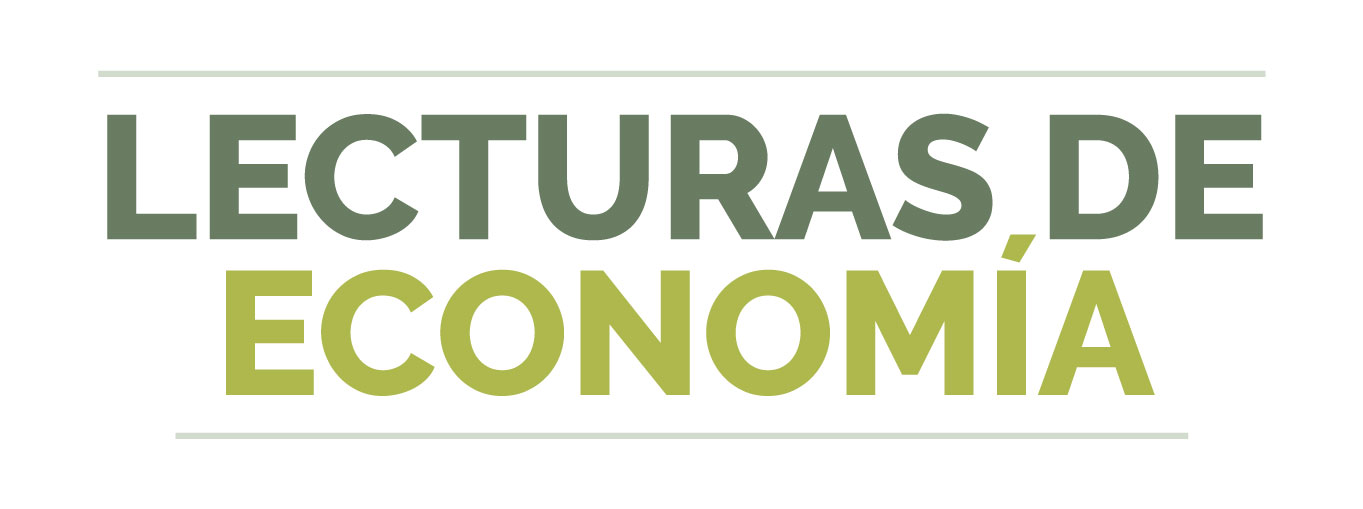











 , respectively, stand for the inflation rate and the per capita (physical) wealth. We have
, respectively, stand for the inflation rate and the per capita (physical) wealth. We have
 stand for the amount of gold owned by the representative household. Current income per capita is given by
stand for the amount of gold owned by the representative household. Current income per capita is given by
 is the interest payment,
is the interest payment,  is the rent revenue from owning gold, w is the wage payment, and (m is the cost of holding money. Let a(t) stand for the total value of assets that the representative household owns. We have
is the rent revenue from owning gold, w is the wage payment, and (m is the cost of holding money. Let a(t) stand for the total value of assets that the representative household owns. We have

 saving, s(t) and consumption of goods, c(t). The budget constraint is given by
saving, s(t) and consumption of goods, c(t). The budget constraint is given by


 .The consumer’s utility function is specified as follows:
.The consumer’s utility function is specified as follows:










 and
and  are functions of
are functions of 
 and
and  .
. 
 and
and  by the following procedure:
by the following procedure:  and
and  by (A2) →
by (A2) →  by (A7) →
by (A7) →  by (A14) →
by (A14) →  by (A12) →
by (A12) →  by (A10) →
by (A10) →  by (A5) →
by (A5) →  ,
, and
and  by (13) →
by (13) →  by (19) →
by (19) →  by (1) →
by (1) → 
 →
→  →
→  by (A3).
by (A3).
 and
and  As shown in the Appendix, the expressions are complicated, so it is difficult to explicitly derive economic implications from the three equations. For illustration, we simulate the model to illustrate the behavior of the system. In the remainder of this study, we specify the parameters in
As shown in the Appendix, the expressions are complicated, so it is difficult to explicitly derive economic implications from the three equations. For illustration, we simulate the model to illustrate the behavior of the system. In the remainder of this study, we specify the parameters in 
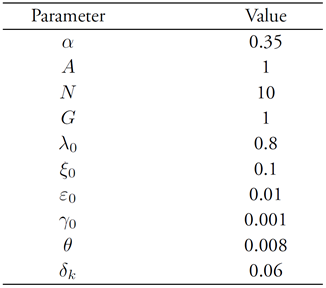


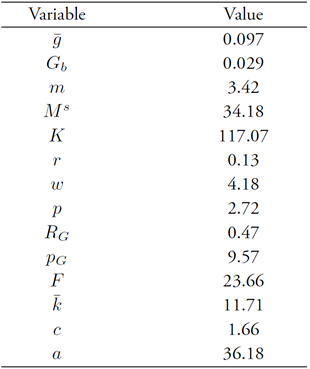
 stand for the percentage rate of change of the variable
stand for the percentage rate of change of the variable  due to changes in the parameter value.
due to changes in the parameter value.  This implies that the money stock is reduced for a fixed amount of gold backing. The simulation results are plotted in
This implies that the money stock is reduced for a fixed amount of gold backing. The simulation results are plotted in 
 The simulation results are plotted in
The simulation results are plotted in 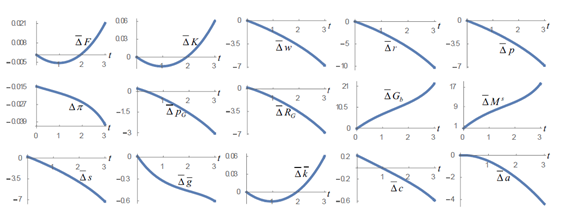
 The simulation results are plotted in
The simulation results are plotted in 

 The simulation results are plotted in
The simulation results are plotted in  . The simulation results are plotted in
. The simulation results are plotted in 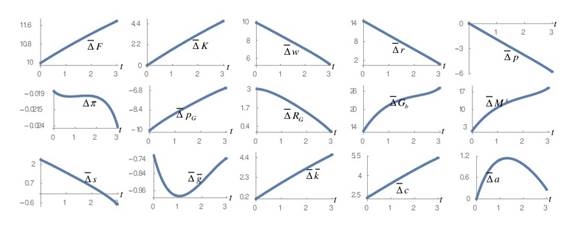
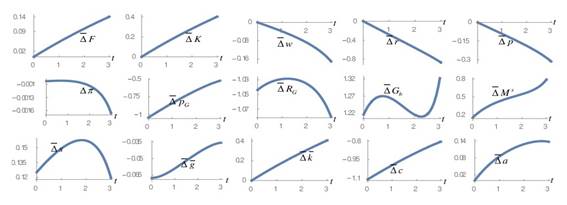
 .The simulation results are plotted in
.The simulation results are plotted in 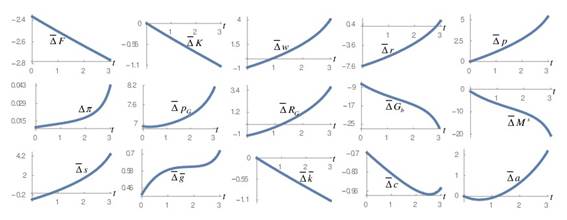



























 and
and  The following procedure shows how to express all the other variables as functions of
The following procedure shows how to express all the other variables as functions of 
 and
and  by (A1) →
by (A1) →  and
and  by (A2) →
by (A2) →  by (A7) →
by (A7) →  by (A14) →
by (A14) →  by (A12) →
by (A12) →  by (A10) →
by (A10) →  by (A5) →
by (A5) → 
 and
and  by (13) →
by (13) →  by (19) → /by (1) →
by (19) → /by (1) →  →
→  →
→  by (A3).
by (A3).







